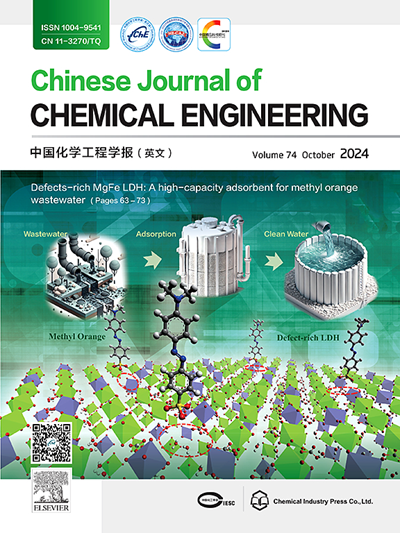Improving CO2 solubility in a hybrid sorbent of 1-hexyl-3-methylimidazolium bis(trifluoromethylsulfonyl)imide/mesoporous titanium dioxide/water with confinement effect
IF 3.7
3区 工程技术
Q2 ENGINEERING, CHEMICAL
引用次数: 0
Abstract
Confinement effect is an effective method to enhance carbon dioxide (CO2) solubility. In this study, a hybrid sorbent of 1-hexyl-3-methylimidazolium bis(trifluoromethylsulfonyl)imide ([Hmim][NTf2])/mesoporous titanium dioxide (M-TiO2)/water (H2O) was developed, and its confinement effect was regulated by changing the pore structure of M-TiO2. CO2 solubility in the hybrid sorbent was measured experimentally, and the thermodynamic properties including Henry's constant and desorption enthalpy were calculated. Furthermore, the confinement effect in the hybrid sorbent was quantified. Additionally, the hybrid sorbent was recycled with a multi-cycle experiment. The results showed that M-TiO2 calcined at 773.2 K (MT500) could lead to an efficient confinement effect. CO2 solubility in the hybrid sorbent increased by 49.8% compared to that of H2O when the mass fraction of [Hmim][NTf2]/MT500 was 5.0% (mass), where the contribution of confinement effect on Gibbs free energy occupied 5.2%.
求助全文
约1分钟内获得全文
求助全文
来源期刊

Chinese Journal of Chemical Engineering
工程技术-工程:化工
CiteScore
6.60
自引率
5.30%
发文量
4309
审稿时长
31 days
期刊介绍:
The Chinese Journal of Chemical Engineering (Monthly, started in 1982) is the official journal of the Chemical Industry and Engineering Society of China and published by the Chemical Industry Press Co. Ltd. The aim of the journal is to develop the international exchange of scientific and technical information in the field of chemical engineering. It publishes original research papers that cover the major advancements and achievements in chemical engineering in China as well as some articles from overseas contributors.
The topics of journal include chemical engineering, chemical technology, biochemical engineering, energy and environmental engineering and other relevant fields. Papers are published on the basis of their relevance to theoretical research, practical application or potential uses in the industry as Research Papers, Communications, Reviews and Perspectives. Prominent domestic and overseas chemical experts and scholars have been invited to form an International Advisory Board and the Editorial Committee. It enjoys recognition among Chinese academia and industry as a reliable source of information of what is going on in chemical engineering research, both domestic and abroad.
 求助内容:
求助内容: 应助结果提醒方式:
应助结果提醒方式:


